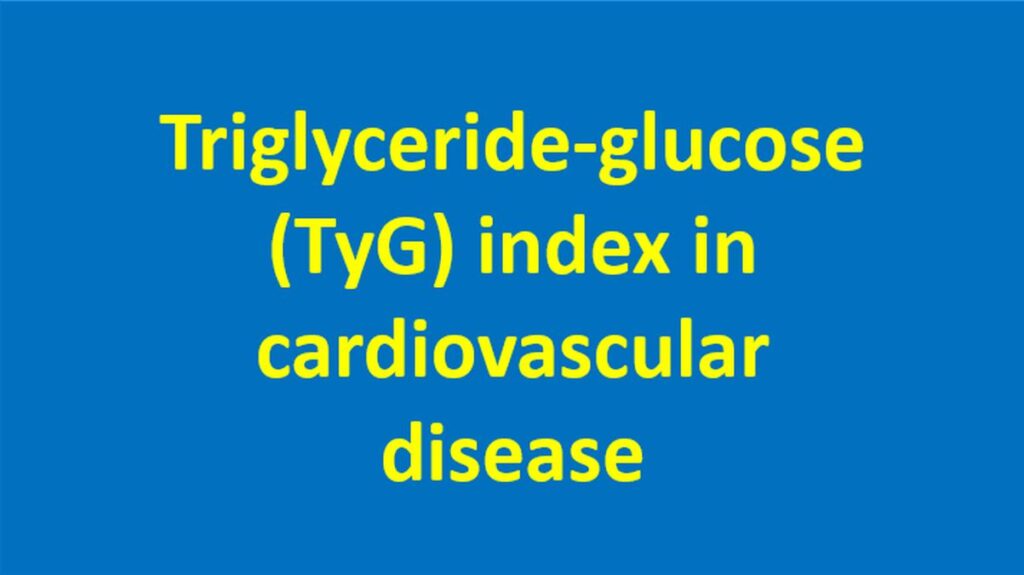Triglyceride-glucose (TyG) index in cardiovascular disease
Triglyceride glucose index (TyG) calculated from fasting triglycerides (TG) and glucose levels (FBG) was proposed as a surrogate of insulin resistance in 2008 as insulin assay was expensive and not available in most laboratories in cities of underdeveloped countries [1]. TyG index is calculated with the following formula: TyG index = Ln (serum TG [mg/dl] × FBG [mg/dl]/2).
In the seminal study, 748 apparently healthy subjects with mean age of 41.4 years were enrolled. 241 of them were identified as having insulin resistance by homeostasis model assessment of insulin resistance (HOMA-IR) index. HOMA-IR is calculated according to the formula: fasting insulin (microU/L) x fasting glucose (mmol/L)/22.5. New diagnoses of impaired fasting glucose (IFG), impaired glucose tolerance (IGT), and IFG + IGT were established in 145, 54, and 75 individuals respectively. The best TyG index for diagnosis of insulin resistance in that study was Ln 4.65 with sensitivity of 84.0% and specificity of 45.0% [1].
Association between Triglyceride-glucose index and symptomatic coronary artery disease was reported in a study of 2330 patients in secondary care from Brazilian Cardioprotective Nutritional Program Trial (BALANCE Program Trial). Prevalence of symptomatic coronary artery disease was 1.16 times higher in patients in the last tertile of TyG index compared to those in the first tertile. In addition, they observed a positive association between TyG index and risk factors for cardiovascular disease [2]. But an editorial published in the same journal in 2020 mentioned that correlations do not imply causation and hence the use of TyG index in patients with coronary artery disease was questionable [3].
An association between triglyceride-glucose index and risk of arterial stiffness was noted in a study of 6028 participants. Authors suggested that subjects with a higher TyG index should be aware of the risk of progression of arterial stiffness and implement lifestyle changes in an early stage [4].
Another study enrolled 1095 nondiabetic healthy subjects with no previous history of coronary artery disease. Those with high TyG index had higher pulse wave velocity, left ventricular mass index, body mass index, rates of hypertension, and were predominately male. Authors concluded that the study shows a relationship between TyG index and subclinical atherosclerotic vascular disease, even in patients without a history of atherosclerotic cardiovascular disease or diabetes [5].
Elevated levels of the baseline and long term TyG index were associated with an increased risk of myocardial infarction in a large cohort study of 98,849 participants. The study had a median follow up of 11.03 years and reported 1555 incident myocardial infarctions [6]. Role of TyG index in predicting cardiovascular outcomes was checked in a nested case-control study among 3,745 patients with stable coronary artery disease. Patients were followed up for 11,235 person-years. It was shown that TyG index was positively associated with future cardiovascular events [7].
Triglyceride-glucose index has been shown to predict the complexity of peripheral artery disease (PAD). 71 patients with PAD who underwent percutaneous peripheral intervention were analyzed retrospectively. 93% were males and mean age was 63.3 years. Severity and complexity of PAD was assessed by TransAtlantic InterSociety Consensus-II (TASC-II) classification. Those with TASC A-B lesions were included in Group 1, and those with TASC C-D lesions were included in Group 2. Platelet count and TyG index were significantly higher in group 2. Authors concluded that TyG index was significantly correlated with TASC-II, Rutherford category, HbA1c, and HDL-C [8].
Findings from the Atherosclerosis Risk in Communities (ARIC) Study also showed that higher TyG index is independently associated with an increased risk of incident PAD. There were 12,320 participants with mean age of 54.3 years free of a history of PAD at baseline in the study. 1300 participants developed PAD over a median follow-up of 23 years [9].
Heart failure with preserved ejection fraction (HFpEF) in essential hypertensive patients is yet another association documented with TyG index. The study enrolled 559 hypertensive patients of which 273 had HFpEF while 286 did not have HFpEF. TyG index was higher in HFpEF patients than in non-HFpEF patients and related to diastolic function in hypertensive patients [10].
References
- Simental-Mendía LE, Rodríguez-Morán M, Guerrero-Romero F. The product of fasting glucose and triglycerides as surrogate for identifying insulin resistance in apparently healthy subjects. Metab Syndr Relat Disord. 2008 Dec;6(4):299-304. doi: 10.1089/met.2008.0034. PMID: 19067533.
- da Silva A, Caldas APS, Hermsdorff HHM, Bersch-Ferreira ÂC, Torreglosa CR, Weber B, Bressan J. Triglyceride-glucose index is associated with symptomatic coronary artery disease in patients in secondary care. Cardiovasc Diabetol. 2019 Jul 11;18(1):89. doi: 10.1186/s12933-019-0893-2. PMID: 31296225; PMCID: PMC6625050.
- Alizargar J, Bai CH, Hsieh NC, Wu SV. Use of the triglyceride-glucose index (TyG) in cardiovascular disease patients. Cardiovasc Diabetol. 2020 Jan 15;19(1):8. doi: 10.1186/s12933-019-0982-2. PMID: 31941513; PMCID: PMC6963998.
- Wu S, Xu L, Wu M, Chen S, Wang Y, Tian Y. Association between triglyceride-glucose index and risk of arterial stiffness: a cohort study. Cardiovasc Diabetol. 2021 Jul 16;20(1):146. doi: 10.1186/s12933-021-01342-2. PMID: 34271940; PMCID: PMC8285795.
- Baydar O, Kilic A, Okcuoglu J, Apaydin Z, Can MM. The Triglyceride-Glucose Index, a Predictor of Insulin Resistance, Is Associated With Subclinical Atherosclerosis. Angiology. 2021 Nov;72(10):994-1000. doi: 10.1177/00033197211007719. Epub 2021 Apr 23. PMID: 33887969.
- Tian X, Zuo Y, Chen S, Liu Q, Tao B, Wu S, Wang A. Triglyceride-glucose index is associated with the risk of myocardial infarction: an 11-year prospective study in the Kailuan cohort. Cardiovasc Diabetol. 2021 Jan 12;20(1):19. doi: 10.1186/s12933-020-01210-5. PMID: 33435964; PMCID: PMC7802156.
- Jin JL, Cao YX, Wu LG, You XD, Guo YL, Wu NQ, Zhu CG, Gao Y, Dong QT, Zhang HW, Sun D, Liu G, Dong Q, Li JJ. Triglyceride glucose index for predicting cardiovascular outcomes in patients with coronary artery disease. J Thorac Dis. 2018 Nov;10(11):6137-6146. doi: 10.21037/jtd.2018.10.79. PMID: 30622785; PMCID: PMC6297409.
- Duran Karaduman B, Ayhan H, Keleş T, Bozkurt E. The triglyceride-glucose index predicts peripheral artery disease complexity. Turk J Med Sci. 2020 Aug 26;50(5):1217-1222. doi: 10.3906/sag-2006-180. PMID: 32718124; PMCID: PMC7491281.
- Gao JW, Hao QY, Gao M, Zhang K, Li XZ, Wang JF, Vuitton DA, Zhang SL, Liu PM. Triglyceride-glucose index in the development of peripheral artery disease: findings from the Atherosclerosis Risk in Communities (ARIC) Study. Cardiovasc Diabetol. 2021 Jun 24;20(1):126. doi: 10.1186/s12933-021-01319-1. PMID: 34167539; PMCID: PMC8223290.
- Liao LP, Yang Y, Wu Y, Li W. Correlation analysis of the triglyceride glucose index and heart failure with preserved ejection fraction in essential hypertensive patients. Clin Cardiol. 2022 Jun 29. doi: 10.1002/clc.23881. Epub ahead of print. PMID: 35770315.


